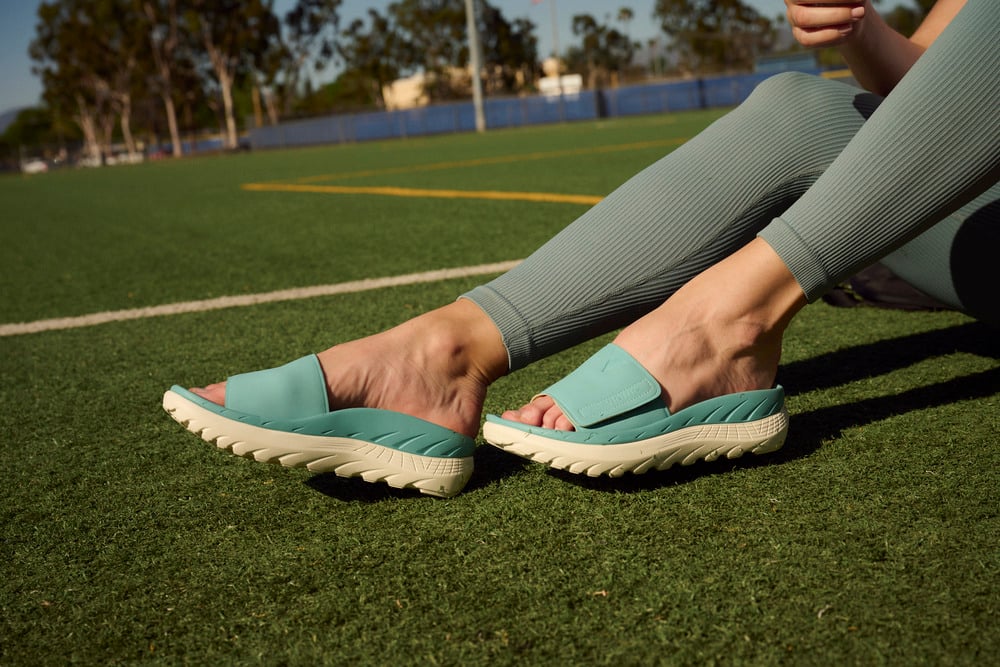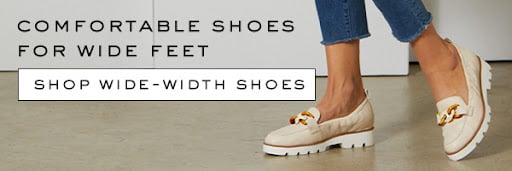
Whether you’re a pro athlete or a proud couch potato, no one is totally invulnerable to getting sore, swollen feet from time to time. Our feet are constantly taking one (at least) for the team every day, and everything from dehydration to pregnancy can leave them feeling puffy or pained. So, what causes swollen feet?
Luckily, foot swelling has just as many solutions as it has causes. If you suddenly feel like you’re walking on two water balloons, this explainer guide will cover 9 possible reasons behind the swelling and how to reduce swelling in your feet.
#1 Determine The Cause of Foot Swelling
A swollen foot can be a bit of a “who-dun-it” mystery. There are numerous reasons why they might feel tender and puffy, from too-tight shoes to the side effects of a new medication. Discovering the cause of yours is the first step in finding an anti-swelling solution for your feet.
So, what causes feet to swell in the first place? Let’s dive into the mechanism of swelling.
When your feet swell, your body is experiencing either an edema (when excess fluid pools in one body area) or inflammation (a healing reaction to any injury or infection).1 Here are just a few causes that could prompt either:
- Dehydration – You might assume that the more water you drink, the more swelling you’d have. However, the opposite is true: When dehydrated, your tissues and organs hold onto their water supply even more. Diuretic substances that encourage the body to release water, like coffee or alcohol, can add to dehydration.
- Diet – If you have a “salt tooth”, then you might be creating a pro-swelling environment. Sodium retains water in the body, an essential part of your health. However, too much sodium can lead to excess fluid retention and swelling.
- Sedentary activity – If you don’t move it, you lose it. In this case, the “it” is healthy, non-swollen feet. Daily activity encourages your circulatory system to pump blood to and from your heart. A sedentary lifestyle reduces circulation and allows gravity to take control, letting blood and bodily fluids pool in your lower half.
- Obesity – Obesity creates extra pressure on the lower body, which could result in vein damage or chronic venous insufficiency—when veins dilate and no longer circulate fluid properly. Obesity-related conditions like diabetes and heart disease can also reduce circulation, leaving behind swollen feet.
- Pregnancy – When your body is growing a baby, it undergoes a whirlwind of changes. One of those just might be swollen or larger feet. The pregnancy hormone relaxin encourages tendons and joints to stretch, including the ones in and around the feet.2 This can leave pregnant women with a larger shoe size, even after giving birth. Also, pregnancy weight gain can decrease circulation and create edema in the lower body.
- Health conditions – If a health condition reduces circulation in any way, it may cause feet swelling. Conditions in the kidneys, liver, and heart can all increase fluid retention. Similarly, lymphedema (swollen lymph nodes), blood clots, and diabetes can leave you with poor circulation and swelling.
- Medications – Unfortunately, certain medications may leave you with tender and puffy feet. The most common medications with this side effect include:3
- Hypertension medications (e.g. Amlodipine)
- Non-steroidal anti-inflammatory drugs (NSAIDs), like Ibuprofen
- Diabetes medication
- Hormonal birth control
- Oral steroids
- Nerve pain drugs
- Healing response – Just got out of knee surgery? Recently sprained your ankle? Then your body may create an inflammatory response to speed up healing, which may leave you with a swollen ankle or feet. Inflammation causes blood vessels in tissues to dilate, allowing more blood into the area for proper healing.
- Tight shoes – When your shoes are tight, your circulation suffers. This may leave you with swelling by the end of the day, as your feet retain more blood and fluids.
#2 Boost Your Hydration
One of the easiest ways to get rid of swelling? Drinking more fluids.
Proper hydration will help your body release any retained fluids or edema. Whether your feet swelling is from diet, medications, or pregnancy, more water can never hurt. Encourage your body to release any swelling with these hydrating tips:4
- Drink at least 8 cups of water per day
- Reduce diuretic substances (e.g. coffee, soda, and alcohol)
- Add at least 12oz of water per hour of exercise
- Eat water-rich fruits and vegetables, like cucumber and lettuce
- Drink more water in hot weather or conditions
#3 Get Moving
It’s incredible how well movement aids your circulation. Using your muscles forces fluids out of the tissues, encouraging your body to pump blood back up to the heart.5 In fact, research shows that regular ankle and hip movements while standing may decrease swelling and pain in the lower body.6
Not sure where to start? Add these easy anti-swelling exercise tips to your daily routine:
- When sitting, flex your knees and ankles regularly
- Get up and move at least once per hour during the day
- Add 150 minutes of moderate-intensity exercise to your week
- Try low-impact exercises like yoga, pilates, or swimming to protect your joints
#4 Pull on Compression Socks
When swelling becomes uncomfortable or chronic, compression socks can be your ultimate quick fix. These socks fit snugly around the lower leg to increase blood circulation and keep fluid from pooling in the ankles and feet.7
If you’re new to compression socks, it’s best to start with a lightweight pair. Too much pressure or squeezing may have the opposite effect and increase swelling.
#5 Wear Comfy, Well-Fitted Shoes
Stilettos and flip-flops aren’t the only shoes that will leave your feet aching. If your shoes have poor support or a tight fit, it may cut off circulation or increase inflammation—a recipe for swelling.
Instead, find shoes that fully support the foot’s contours. Vionic’s biodynamic shoe designs are proven to alleviate foot pain, offering arch support and stability for every size. Additionally, orthotic shoe inserts add instant arch relief and support to any shoe. No matter if you work on your feet or at a desk, the right shoes can keep your feet healthy and pain-free.
#6 Scale Back on Sodium, Up Your Potassium
In the body, sodium, and potassium have a critical see-saw relationship: While sodium retains water in your cells and increases blood pressure, potassium relaxes blood vessels to release sodium.8>/sup> If your diet is high in sodium and low in potassium, it could lead to edema in the feet.
To start, try to consume less than the recommended 2,300mg of sodium per day (about 1 teaspoon of salt).9 You can also add potassium-rich foods to your diet, such as:
- Bananas
- Sweet potatoes
- White beans
- Lentils
- Avocado
- Beet greens
- Spinach
#7 Try Increasing Your Magnesium Intake
An essential mineral, magnesium is shown to reduce fluid retention and edema. Whether you’re low on magnesium or just need an anti-swelling aid, this mineral could be your soothing friend. You can get more magnesium in your diet by:7
- Eating magnesium-rich foods – Magnesium is present in countless foods that are rich in nutrients. Try to add legumes, low-fat dairy, nuts, tofu, spinach, and dark chocolate to your plate.
- Taking a supplement – For an easy boost, a magnesium supplement can help minimize any deficiency. Take about 200mg to 400mg daily to reduce foot or ankle swelling.
- Soaking in Epsom salts – Magnesium can also be absorbed through the skin, especially when found in Epsom salt. By soaking swollen feet in a bath with Epsom salt, you can soothe any swelling (and get some relaxing “me time”).
#8 Elevate Your Feet
It almost seems too simple to work, but playing with gravity can relieve swelling. To counteract gravity pulling on your legs all day, simply place your legs above your head. This will reverse the pull of gravity to drain any retained fluids from your lower body.
To get gravity on your side, elevate your legs with these tips:
- Lie down on the floor and prop your legs up against a wall
- When sleeping, prop your legs with pillows
- Try inverted yoga poses that place the legs above the heart
#9 Massage It Out
In your body, the lymphatic system plays a major part in fluid draining and swelling. This system contains vessels and glands that transport lymph, a fluid that washes out waste products and bacteria. If your lymphatic system has a blockage, manual massage can ease it back into working. Another plus? Massages just feel great.
Start by applying an essential oil to massage your feet. Thyme, clove, and peppermint oils have been shown to have anti-inflammatory properties, which could help further reduce foot swelling.10 Then, give firm and pressured strokes on your feet that move up toward the heart. You may even see immediate results after just one massage!
Soothe Swelling in Style with Vionic
Few people will go their whole lives without experiencing a swollen leg or feet, and most of us could stand to gain from more supportive footwear. Calm current swelling and build a better future for your feet by giving them the high-quality shoes they deserve.
From women’s loafers to men’s sandals, Vionic fuses chic styles and orthotic design to create a shoe that feels as good as it looks. Our proprietary VioMotion™ Technology delivers comfort through stability, arch support, and cushioning, so you can feel the difference—shoes on or off—from head to toe.
Learn why Vionic steals the thumbs up” from the American Podiatric Medical Association by finding a sleek new pair today.
Sources:
- Cronkleton, Emily. “Swollen Foot, Ankle, or Leg: Causes, Treatments, and More.” Healthline. Updated 14 February, 2023.https://www.healthline.com/health/swollen-ankle-and-leg#overview
- Horsager-Boehrer, Robyn.”5 ways to manage swollen legs and feet during pregnancy.” UT Southwestern Medical Center. 14 September, 2021. https://utswmed.org/medblog/swollen-feet-during-pregnancy/
- “These 7 Medications Can Cause Puffy Legs and Ankles.” GoodRX Health. https://www.goodrx.com/drugs/side-effects/these-7-medications-can-cause-puffy-legs-and-ankles
- Simson, Rachel. “10 healthy ways to increase your fluid intake.” Roswell Park Cancer Center. 9 August, 2021. https://www.roswellpark.org/cancertalk/202108/10-healthy-ways-increase-your-fluid-intake
- “Edema.” Mayo Clinic.https://www.mayoclinic.org/diseases-conditions/edema/diagnosis-treatment/drc-20366532
- Lin, Yen-Hui et al. “Effectiveness of leg movement in reducing leg swelling and discomfort in lower extremities.”Applied ergonomicsvol. 43,6 (2012): 1033-7. doi:10.1016/j.apergo.2012.03.002
- “Swollen Feet and Ankles: Treatments to Try.” Cleveland Clinic.https://health.clevelandclinic.org/6-best-ways-relieve-swollen-feet-ankles-home/
- “Potassium.” Harvard T.H. Chan School of Public Health.https://www.hsph.harvard.edu/nutritionsource/potassium/
- “Sodium in Your Diet.” FDA. https://www.fda.gov/food/nutrition-education-resources-materials/sodium-your-diet
- “Best Essential Oils for Inflammation.” Martha Stewart Living. Updared 21, November, 2022. https://www.marthastewart.com/8222714/best-essential-oils-inflammation


Leave a Reply